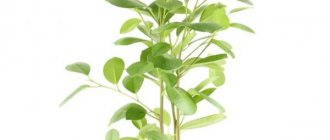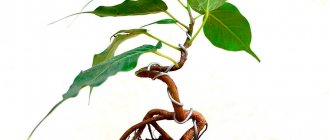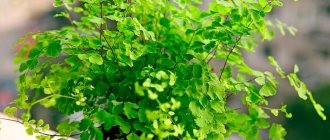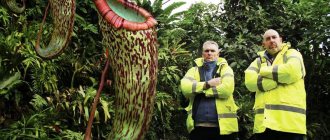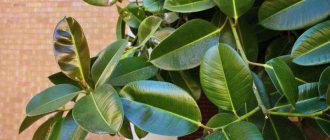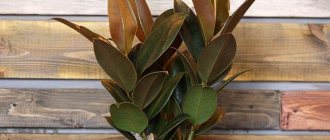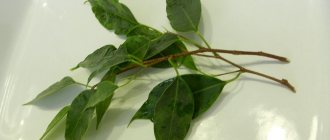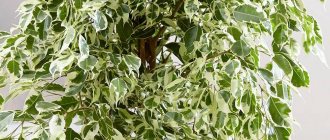» Flowers » Ficus Abidjan - content rules
0
561
Article rating
Ficus Abidjan is very popular in home floriculture. This flower was named after the African city of Abidjan, which is located in the state of Cote d'Ivoire. Let's look at what this plant looks like, how to plant it correctly and care for it at home.
- Growing conditions
- Rules of care
- Watering
- Feeding
- Crown trimming and shaping
- Reproduction
- Cuttings
- By layering
- Diseases and pests
- Problems during cultivation
- Signs and superstitions
Ficus Abidjan - content rules
Peculiarities
The homeland of the Abidjan ficus is West Africa, the city of Abidjan, which translated from the local language means “cut foliage”.
This is a beautiful, luxurious tree of the rubber genus with dense glossy dark green leaves. It is characterized by oval leaves with a pointed end and a smooth surface. Initially they unfold red. Gradually, only the burgundy vein remains.
The length of the leaves is 20-30 cm, width is 15-20 cm. The stem of the tree is green, the bottom is grayish, tree-like.
In indoor conditions, ficus grows up to one and a half meters, without growing much in width.
The plant is a long-livers - it can live up to 50 years. It will not bloom, but will decorate the interior. Propagated by cuttings.
How to properly form a tree crown
Caring for this plant will not be difficult. And even more so, the main thing is to follow all the rules and instructions when caring for the crown. At home, ficus grows quite quickly. The growth of a young tree in 1 year can be over 50 cm. To avoid a meter-long palm tree at home occupying the entire space, it is necessary to connect the shoots so that the tree does not rapidly grow and stretch upward. This type of ficus belongs to very quickly growing and developing plants, but still such upward impulses must be restrained, because the larger the flower, the larger the area it needs.
The main stem of the ficus should be connected at a height of approximately 20 cm, so as not to cause much damage to the tree and not bring the plant to a state of stress. Stems that will grow to the side also need to be trimmed. In this way you can create a beautiful shape for the ficus. Ficus Abidjan in the photo allows you to see its beauty.
Care
Caring for the Abidjan ficus is simple and consists of providing proper lighting, regular watering, comfortable temperature, periodic replanting, and fertilizing.
First of all, the plant needs to be provided with proper lighting. The ficus is placed in such a place that it does not have to be moved frequently.
It is best to choose the east or southeast sides. There is soft, favorable, diffused light here. Although caring for the ficus Abidjan at home involves placing the pot with the plant in cool partial shade, but so that it is not deprived of sunlight. When placed in a dark corner, the tree will shed its leaves and begin to wither.
Summing up
Growing ficus does not require the creation of unusual conditions. You can always find a place in the house with the necessary lighting and temperature parameters.
All that remains is to water regularly and feed the plant as needed. The evergreen bush is very decorative and, in addition to its aesthetic benefits, effectively purifies the air in the house.
When purchasing a ficus Abidjan, you need to remember that the long-lived plant will delight you with its extraordinary beauty for many years, but will also require proper care in return.
Sources:
https://fikusdoma.ru/fikus-abidzhan-uhod-razmnozheniye/ https://selo.guru/rastenievodstvo/dekorativnolistvennye/derevjya/fikus/vidi-f/kauchukonostnyj/v-kauch/abidzhan.html https://prozvety .ru/katalog-rastenij/dekorativno-listvennye/fikus-abidzhan
Watering
Caring for ficus Abidjan involves proper watering. The tree should not be overdried or overwatered. To ensure the required amount of liquid, it is enough to water twice a week. In winter, the number of waterings is reduced to once a week.
You can find out whether a plant needs water treatments by looking at the top layer of soil. If it has dried out by 2-3 centimeters, then this indicates the need to water the ficus.
During the heating season, the tree is sprayed. It is recommended to use settled water at room temperature. Water is drawn from the tap and immediately watered with it on the tree.
Unsettled water contains a lot of lime and nitrates, which negatively affect the general condition of the foliage: a white coating forms on them, which is difficult to get rid of.
Caring for ficus rubber at home
Illumination
Ficus rubber is a light-loving plant, so the light should be bright, but always diffused, since direct rays of the sun can harm it. You can choose a place for it in a little shade, but in this case its growth and development will be slower, and be prepared for the fact that its lower foliage will fly off.
Temperature
In spring and summer, the bush grows best at an indoor temperature of 20 to 25 degrees. A short-term increase in temperature to 30 degrees will not cause much harm to him. In winter, it is recommended to move it to a cool place, but make sure that the air temperature does not fall below 15 degrees.
Watering and air humidity
It is necessary to moisten the soil mixture in the pot only when the top layer is about 2 fingers dry in depth. On average, in the spring-summer period, watering is carried out 1 or 2 times every 7 days, and in the cold season - once a week. If watering is more frequent, this may cause the leaves to fly away.
In spring and summer, to increase the level of air humidity, the foliage is systematically sprayed with warm water from a spray bottle, and it is also washed with a dampened soft cloth once every half month. And once every 30 days, it is advisable to give the ficus a warm shower, while the substrate in the pot must be protected from water by covering it with film. In winter, it is not recommended to moisten the foliage; instead, wipe it with a damp swab and place it away from operating heating appliances.
Fertilizer
In order for the bush to grow and develop within normal limits, it needs to be regularly fed once every 15 days from April to September. To do this, it is recommended to alternately use liquid organic matter and mineral fertilizers with a high nitrogen content. For example, after watering, you can pour a Nitrophoska solution under the plant (for 1 liter of water, ½ tsp of the substance), and after half a month it is fed with mullein infusion, also after watering. Do not allow the nutrient mixture to get on the surface of growth buds or foliage. You cannot polish sheet plates with chemicals; in extreme cases, you can use non-alcoholic beer for this.
Replanting ficus rubber
While the bush is young, it needs annual replanting, which is carried out in the spring months or in the first weeks of summer. An adult bush is replanted only when absolutely necessary, after its root system becomes very crowded in the container (on average, once every 2 or 3 years). A sign that the soil mixture is depleted and should definitely be replaced with fresh one is that after watering the liquid flows into the pan too quickly.
When choosing a new pot, you need to take into account that it should be 50–60 mm deeper and 40–50 mm larger in diameter compared to the old one. If the plant is very old, then during transplantation it may be severely damaged, which will lead to its death. In this regard, experienced gardeners advise not to disturb such a ficus with transplants, but simply regularly change the top layer of soil mixture 30 mm thick with fresh one once a year. The soil mixture suitable for growing ficus should include peat, leaf and turf soil, as well as river sand (1:1:1:1). If you wish, you can purchase ready-made soil mixture for ficus. A universal soil mixture is also suitable for replanting, but you will need to add a small amount of river sand into it.
Pour a good layer of drainage into the pot, and then carefully remove the flower along with the earthen lump from the old container and transfer it to the new one. Fill all the voids with fresh soil mixture until the pot is full.
Ficus transplant at home Part 1
Trimming
Pruning is needed in order to restrain the growth of the bush, as well as to increase the amount of foliage, because over the years the lower leaf plates begin to fly off. Often, novice gardeners, wanting their ficus to branch, cut off its top. However, this does not make it begin to branch; at best, one of the upper buds located on the trunk awakens. To achieve more, it is recommended to trim 5-6 internodes. The top part of a bush that has grown too quickly can be cut off, it is first rooted, and then planted in the same container. When the stems reach the maximum allowable height from your point of view, they will need to be trimmed again. Pruning should be done in early spring, otherwise the lateral buds will not wake up, and the highest point of growth will begin to grow again. Trim the plant with a very sharp, pre-disinfected blade. The milky juice that is released after pruning must be removed with running water.
If you want your home to be decorated with a lush ficus bush, then several plants are planted in one container at once. To grow it, choose a slightly shaded place, while the bush is systematically rotated around its axis, this is necessary so that the stems do not bend, as they begin to reach towards the light source. If you planted only one plant in a pot and want to make it more magnificent, then try to awaken the dormant buds located on the stem by pruning (how to do this is described in more detail above). Also, to increase the splendor of the plant, some gardeners use the method of piercing the trunk to a depth of 1/3 of its thickness. Such stimulation begins from the top of the trunk, and then gradually drops lower.
The upper part of a young bush is tilted down to the maximum, after which it needs to be fixed. The bud that is higher than all the others awakens and gives off a side shoot. As soon as this happens, the flower is returned to its normal position.
How to form ficus rubbery
Temperature
Caring for ficus Abidjan at home involves observing the temperature regime. The plant feels comfortable at temperatures from +18 to +24 degrees in the warm season, and in winter it needs to be provided with a temperature of 16-18 degrees.
If the room is hot (above +25 °C), then the ficus needs additional moisture in the form of spraying. In the cold season, the pot is additionally insulated with warm fabric. If the pot is on the floor, and the tree itself does not have time to grow, then it must be placed on an elevated surface, since hypothermia greatly harms the roots.
Features of reproduction
If it is necessary to obtain new specimens, the Abidjan ficus is propagated. This can be done in different ways: layering, cuttings, leaves.
The easiest way to get a new plant is by cuttings - this is the most affordable method. For rooting, cut off the top and place in water. It is changed as often as possible, since juice flows out of the cut area. The container with the cutting is placed in a moderately lit place. After two weeks, the cutting gives its first roots. As soon as they grow to 1.5-2 cm, the ficus can be transplanted into a permanent container. To improve rooting, the seedling is placed in a greenhouse for two weeks.
Reproduction by layering is a more painstaking way of obtaining new plants, although the process itself is much more interesting. For propagation, the trunk is slightly cut, by about one third. Sand is placed in the incision, due to which the incision will not heal. Then this place is covered with damp moss, and a plastic film is placed on top. Moss is regularly moistened. After some time, roots will appear through the layer of moss. When they grow up, the shoot is cut off from the trunk and planted in a separate container, where it will further take root.
Propagation from ficus Abidjan leaves is difficult. In order to get a new plant, it is necessary to cut off the leaf with part of the trunk. The workpiece is planted in wet sand and covered with polyethylene. In a month the roots will sprout. You can try to root a ficus with a leaf without a cutting, but in this case the chances of success will be 50/50.
How to propagate ficus
Ficus Abidjan can be propagated in two ways:
- cuttings,
- bends.
To obtain a full-fledged cutting, you need to cut off the apical stem of the plant, place it in water and, after waiting for the roots to appear, plant it in a pot. Or immediately plant it in the ground, covering it with film to create a greenhouse effect. You can also root cuttings in peat tablets.
To propagate it by cuttings, you need to cut the trunk of the tree by one third and place a pinch of coarse sand in the cut so that it does not grow together. Wrap this area with damp moss and polyethylene. When the roots break through the moss, the stem is cut off and planted in a separate pot.
Transfer
To get the Abidjan ficus in the photo, home care involves periodic replanting.
After purchase, the plant must be transplanted into another soil, since the transport mixture is not suitable for further development, it does not contain nutrients. However, you should not replant immediately; you need to wait a couple of weeks. This is necessary so that the ficus acclimatizes and gets used to the new place. Ficus trees often have a hard time with a change in environment and can lose their leaves and even die. After two weeks, you can safely carry out the transplant. To do this, take a loose, nutritious soil mixture with a neutral pH level. You can make the composition yourself or transplant the plant into a ready-made composition for ficus. When making it yourself, take turf soil, peat, leaf soil and sand in equal proportions.
A drainage made of broken crumbs or expanded clay is placed at the bottom of the pot. You can add a couple of pieces of charcoal. Before transplanting, the plant is watered generously, then carefully removed from the pot and transplanted into a new container. It should be 2-3 cm larger than the previous one. After planting, the ficus is watered.
To grow a beautiful ficus Abidjan (see photo in the article), it is necessary to replant the plant annually into a larger container. After three years, transshipment is carried out once every 2 years. For large trees, the top layer of soil is replaced.
Formation
Abidjan differs from other varieties in its growth rate - it quickly develops upward, almost without forming lateral branches. In good light, the main stem will grow rapidly, giving an increase of about half a meter per year. Because of this, the plant is limited in growth during formation. It helps to form a beautiful tree.
The first pruning is carried out at the height required, measuring approximately 30 cm from the top. Side shoots are pinched at a distance of 10 cm from the top. With this method, new branches begin to form on the upper bud.
Usually, during formation, the growth of only one point is activated. Therefore, in the photo there are often several bushes planted in one container. This growing method allows you to get a lush shrub and make it decorative.
Tree formation is carried out in summer or spring.
Diseases, pests
Ficuses are capricious plants. They can suffer from a variety of diseases and are attacked by pests.
- Yellowed leaves. With a lack or excess of moisture, the leaves of the plant begin to turn yellow. Therefore, it is recommended to immediately pay attention to the soil moisture level when making the first changes. If it is too wet, then it is dried, reducing watering, and if it is dry, watering is increased.
- The leaves are falling. With a lack of nutrients and acclimatization, the plant sheds its leaves.
- Darkening of leaf tips. Too high a temperature and lack of moisture lead to darkening of the tips of the leaves.
- Powdery mildew. If a white coating and then droplets appear on the leaves, the tree should be immediately treated with fungicides. It is carried out strictly according to the instructions on the packaging.
- Spider mite. Among the pests, ficus trees are most often affected by spider mites. Pests appear due to low air humidity. First, small yellow spots form on the leaves, then they increase in size and the leaves turn yellow. For prevention, you should spray the foliage with a soap solution and humidify the air.
- Shield. Ficus trees are often affected by scale insects. The presence of a pest is indicated by brown spots on the leaves. Gradually they begin to wither and fall off. You can get rid of the pest by treating the tree with special preparations, wiping the leaves with Actellik solution and other preparations.
- Centipede. If there is a centipede in the soil, the plant should be replanted after first disinfecting the container and the new substrate. The old soil is completely washed away from the roots. If the plant is small, you can speed up rooting by creating greenhouse conditions.
Signs and beliefs
Different peoples have their own beliefs and signs associated with trees. According to Slavic signs, ficus Abidjan gives rise to discord in the house and negative emotions, and the Thais believe that the plant is capable of expelling evil spirits and cleansing the house.
In ancient times, even before the revolution, every aristocratic family had a ficus. The plant was believed to bring good luck and prosperity. It helps to move up the career ladder and improve family relationships.
During Soviet times, people began to get rid of trees, considering them a relic of the revolutionary era. After the war, when many men died, ficus trees began to be considered negative, blaming them for all the troubles. It was noticed that the men did not return from the front to those houses where the ficus grew.
There is a mention of ficus in the Bible. It says that the plant provided the first clothing before Eve and Adam, after they were expelled from Eden. A close relative of the ficus, the fig was the first food for the exiles. Since then, the plant has become a symbol of family well-being.
Since biblical times, a sign has been born that if a girl runs around a plant, she will soon become pregnant.
If a couple wants to have children, according to signs, they should place the ficus in the western part of the bedroom. As soon as the plant has a new shoot, expect an addition to the family soon. This shoot is planted in a separate pot.
Characteristics of the variety
Abidjan is one of the most common varieties of rubber-bearing ficus (elastica). The plant, originally from Asia, despite the fear of drafts and love of the sun, has successfully adapted to our country and successfully grows in houses and apartments.
- height about 1.5 m;
- the stem is thick, fleshy, green;
- leaves are dense, leathery with a glossy surface, oval, pointed at the tips;
- sheet plate size - 27x17 cm;
- in adult specimens over 8 years of age, slight branching is observed - shoots grow at an angle of 40-45°, densely covered with leaves;
- The root system is branched with numerous small roots.

